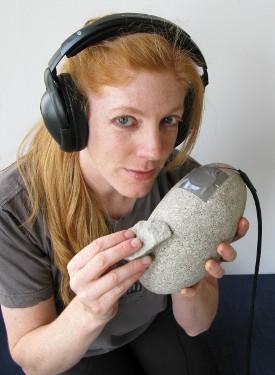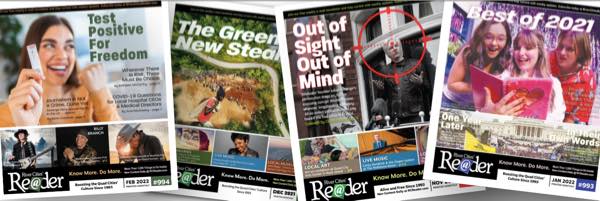
Claire Kovacs is in her third year as director of the Augustana Teaching Museum of Art, and she said that from the outset she needed to answer one question.
“One of the things that I’ve been thinking about since the moment that I even considered coming to Augustana,” she said, “was ‘What is the purpose of an art museum when the Figge is across the river?’”
The answer can be seen this month in a pair of free public events: the Guerrilla Girls’ January 18 lecture in Centennial Hall, and the January 11 performance collaboration of visual artist Oona Stern and composer Cheryl Leonard in Wallenberg Hall.
Both events are related to exhibits at the museum – the fall display of a portfolio of Guerrilla Girls posters, and the current show Art Above 66° 33', which explores issues in the polar regions. Both programs (and their related exhibits) tie directly into Augustana academic programs – the Women’s & Gender Studies program with the Guerrilla Girls, and the Center for Polar Studies with Stern/Leonard and Art Above 66° 33'.
And both were designed to appeal to the larger community, to explore the ideas of what art and artistic process are, and to expand the museum’s role beyond having art on the gallery walls.
Kovacs said she has twin missions. First, “I’m trying to bring in art that helps us deal with or grapple with contemporary issues, ... thinking about how it can either be a lens into an issue, a mechanism to talk about an issue, or a way for multiple perspectives to come together on an issue.”
Second, she said, the museum is trying to “utilize art within the liberal-arts framework” of Augustana College. Instead of just presenting fine art for its own sake, the Teaching Museum is working with academic departments to join art with other fields.
So the Guerrilla Girls are a natural fit with Women’s & Gender Studies. The academic program is marking its 30th anniversary this year, Kovacs said, while the Guerrilla Girls celebrated 30 years in 2015. “I was interested in the Guerrilla Girls not because their history is the same history as Augustana, but there are parallel histories going on here,” she said.
“The Guerrilla Girls fulfill ... the need for the museum to engage with contemporary issues because of their attention to issues of structural inequalities – whether that is gender-based inequality, racial, economic, LGBTQ issues. ...
“Whenever I bring in an exhibition, it needs to connect in some way to the curriculum of Augustana ... but then also situates that in our local, regional, national, or international issues. How does that connect to the larger world? It’s not just art sitting and functioning for art’s sake; it serves some larger purpose.”
Kovacs said Augustana purchased a portfolio of Guerrilla Girls work for several reasons. “Next year,” she said, “students won’t have that opportunity [to see the Guerrilla Girls events], so having the portfolio on campus provides a resource for faculty to continue to engage in the issues that the Guerrilla Girls were touching upon.” But she said the acquisition is also “one step in a direction” of filling gaps in the museum’s collection: “It allows us to bring a work that is actively feminist into the collection; we are missing that.”
That illustrates the thoughtful way Kovacs is thinking about the museum and its exhibits.
Another example: Instead of merely presenting Guerrilla Girls work in the gallery space in a traditional way, she also got permission to reprint several posters and paste them on the walls. “I wanted to acknowledge the ephemeral nature of much of their working practice,” she said.
The Guerrilla Girls lecture and Quad City Arts workshops for high-school and college students, she said, represent an interest in showing “a way that art is very active – activist if you will. ... What I’m particularly interested in is: How might their presence here in the Quad Cities possibly affect conversation or enact any sort of change on a local level?”
She later added that her broader interest in museum programming is complementing exhibits without merely regurgitating them: “I don’t want to repeat whatever is happening in the exhibition space. You should just go see the exhibition. ... How do we create programming that augments it and engages with different audiences? ... For me the art museum is more of an entity and less of a physical space.”
With Art Above 66° 33', Kovacs said, the museum was approached by the Center for Polar Studies, which she said was “interested in thinking about how we can talk about the complexity of the polar regions utilizing the visual arts as a jumping-off point or catalyst. ...
“There are two conversations going on in the gallery: the complexity of the polar regions, and then I am also using this exhibition to think about the complexity of artistic process. So we have a variety of different working practices in the galleries, from some straightforward, beautiful watercolors of whale bones to a pretty conceptually complex sound piece.” The exhibit features 11 artists, and the Stern/Leonard performance will be the third program related to the show.
Kovacs said she’s bringing in Stern and Leonard in part because the duo met a residency in Antarctica, and it was important for some of the exhibit’s work to be created in the environment it dealt with – fitting in with a long tradition of artists being part of scientific expeditions.
Stern’s videos will be projected onto a screen while Leonard performs music using found objects from the polar regions – from whale bones to icicles. “I wanted to expand again on what the boundaries of visual art practice was,” Kovacs said.
Oona Stern & Cheryl Leonard’s Polar Soundscapes will be performed on Wednesday, January 11, at 7 p.m. in Augustana College’s Wallenberg Hall (3520 Seventh Avenue, Rock Island). The event is free and open to the public.
For more information on the Augustana Teaching Museum of Art, visit Augustana.edu/arts/art-museum.








